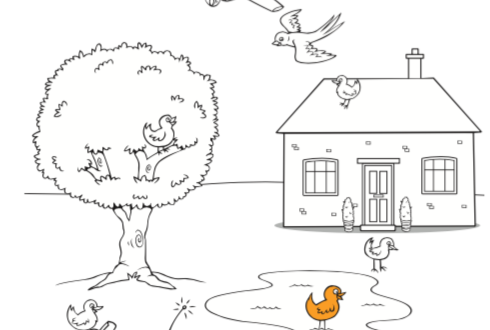About Pre-A1 Starters Listening Part 4
This post, about Pre-A1 Starters Listening Part 4, is inspired by my own personal experience.
Watching candidates doing the Pre-A1 Starters Listening Part 4, I often see them wondering which thing to colour with the colour they heard.
With a few simple tips, I feel they could do this part so much better and also avoid those seconds of uncertainty and anxiety.
So, let’s first consider what candidates have to do in Part 4 of the Pre-A1 Starters Listening.
Candidates see a big scene picture.
In the picture, there will be seven objects, toys or small animals perhaps, in different places in the picture.
One of these objects or animals will be coloured. The rest of the picture is black and white.
Let’s look at an example from Pre-A1 Starters Sample Papers Volume 2:
What’s in this picture?
We can see that the only thing in this picture that is in colour is the orange bird.
The example
So, in the example we will hear the two people speaking and the adult will tell the child to colour that bird orange.
Tip: The example will contain the key word for the things in the picture
Sometimes, young learners might not know or remember the word for the thing or animal they have to colour, but explain that they will hear the word when the people are talking about it in the example.
What do candidates hear?
They listen to a conversation between two people – a grown-up (man or a woman) and a child (girl or boy).
What do candidates have to do after they hear the example?
We know that candidates will have to listen and colour five more birds in the picture.
Tip: Which thing is heard twice, colour only once
Tell young learners that they will hear the information about where each thing (in this case, bird) is twice but they only hear the colour for each bird once.
Tip: The order of the information will vary
Sometimes, they hear the colour first and then the information to identify what to colour. Other times, they hear the information to identify what to colour (here, which bird to colour), then they hear the colour.
Tip: Use your finger to locate the thing to colour
Tell young learners to point to the thing/animal (bird) in the picture if they hear the information, then listen to hear which colour to pick up and use.
Tip: Pick up the colour until you hear the thing to colour
If learners hear the colour first, tell them to pick up that colour and wait to hear which thing/animal to colour.
Tip: Put the colour to one side
If learners don’t understand the information but do understand the colour the first time they listen, they should put that colour crayon to one side and listen carefully for which thing to colour the second time they listen.
Will everyone have enough time to colour?
Yes!
There are pauses in the conversation to give learners time to colour.
Tip: Colouring doesn’t have to be perfect
Tell learners that their colouring doesn’t need to be perfect.
If they have put the right colour on the right thing/animal, they will get the mark.
What about the extra thing/animal?
There are seven birds in this picture.
One is the example (the orange bird).
Learners will colour five more birds.
One bird should not be coloured.
Tip: You will not have to colour one thing/animal
Make sure learners know that there is one extra thing/animal and that this should not be coloured.
If they colour it, they will lose a mark.
What if learners colour the wrong thing/animal and want to change their answer?
Colours cannot be erased.
If they want to change the colour, they can try and change it with the correct colour. But if it doesn’t look the right colour (or they have coloured the object or animal that should not be coloured and realised), they can tell the invigilator and the invigilator can make a note on the test paper.


